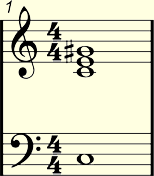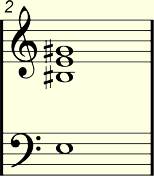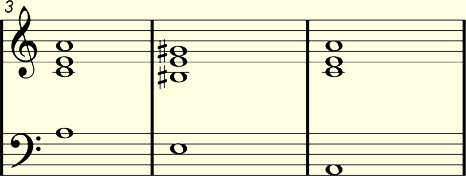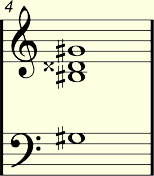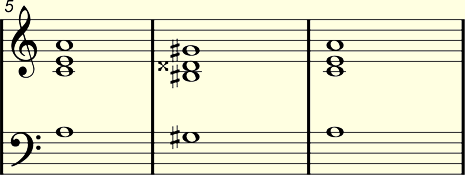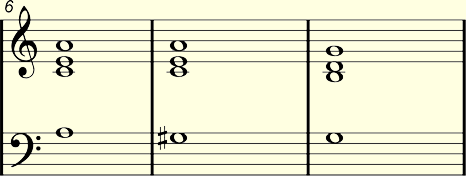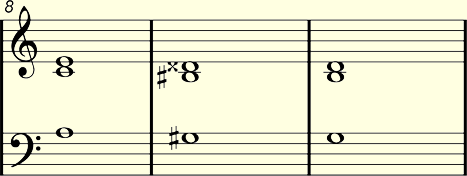Using the Augmented triad
The augmented triad only occurs naturally in the harmonic minor, built on scale tone [sup]b[/sup]3 as [sup]b[/sup]3-5-7, in A minor this would be C-E-G[sup]#[/sup]
[mp3]http://www.bandcoach.org/fp/audio/augTriadHarmMinor-01.mp3[/mp3]
This chord is rarely used as the mediant but, rather, as a substitute dominant chord, which is why in most instances it is used in 1st inversion, i.e. with scale tone 5 in the bass; in this usage the notes would be E-G[sup]#[/sup]-B[sup]#[/sup],
[mp3]http://www.bandcoach.org/fp/audio/augTriadHarmMinor-02.mp3[/mp3]
[mp3]http://www.bandcoach.org/fp/audio/augTriadHarmMinor-03.mp3[/mp3]
We can also use it in 2nd inversion where it becomes VII(#5), i.e. with scale tone 7 in the bass; in this usage the notes would be G[sup]#[/sup]-B[sup]#[/sup]-D[sup]x[/sup]
[mp3]http://www.bandcoach.org/fp/audio/augTriadHarmMinor-04.mp3[/mp3]
[mp3]http://www.bandcoach.org/fp/audio/augTriadHarmMinor-05.mp3[/mp3]
Sometimes it is also seen as the chord formed by moving down a semitone in the bass from the tonic minor chord to the bVII chord like so:
| i | - | i[sub]/7[/sub] | - | [sup]b[/sup]VII |
| Am | - | Am[sub]/G[sup]#[/sup][/sub] | - | G |
[mp3]http://www.bandcoach.org/fp/audio/augTriadHarmMinor-06.mp3[/mp3]
or even as
| i | - | i[sub]/7[/sub] | - | i[sub]/b7[/sub] | - | i[sub]/6[/sub] | - | i[sub]/b6[/sub] |
| Am | - | Am[sub]/G[sup]#[/sup][/sub] | - | Am[sup]7[/sup][sub]/G[/sub] | - | Am[sub]/F[sup]#[/sup][/sub] | - | Am[sub]/F[/sub] |
[mp3]http://www.bandcoach.org/fp/audio/augTriadHarmMinor-07.mp3[/mp3]
(think "Stairway to heaven" or "This Masquerade" or "Something")
[mp3]http://www.bandcoach.org/fp/audio/augTriadHarmMinor-10.mp3[/mp3]
if we remove the tonic A from the right hand in this
progression (the top note) we get the following new functional and actual naming structures:
| i | - | V[sup](#5)[/sup] | - | [sup]b[/sup]VII |
| Am | - | E[sup](#5)[/sup] | - | G |
[mp3]http://www.bandcoach.org/fp/audio/augTriadHarmMinor-08.mp3[/mp3]
or even as
| i | - | V[sup](#5)[/sup] | - | [sup]b[/sup]III[sub]/b7[/sub] | - | vi[su]7b5[/sup] | - | [sup]b[/sup]VI[sup]maj7[/sup] |
| Am | - | E[sup](#5)[/sup] | - | C[sub]/G[/sub] | - | F[sup]#[/sup]m[sup]7b5[/sup] | - | F[sup]maj7[/sup] |
[mp3]http://www.bandcoach.org/fp/audio/augTriadHarmMinor-09.mp3[/mp3]
notes on note names
B[sup]#[/sup] = C
D[sup]x[/sup] = E


